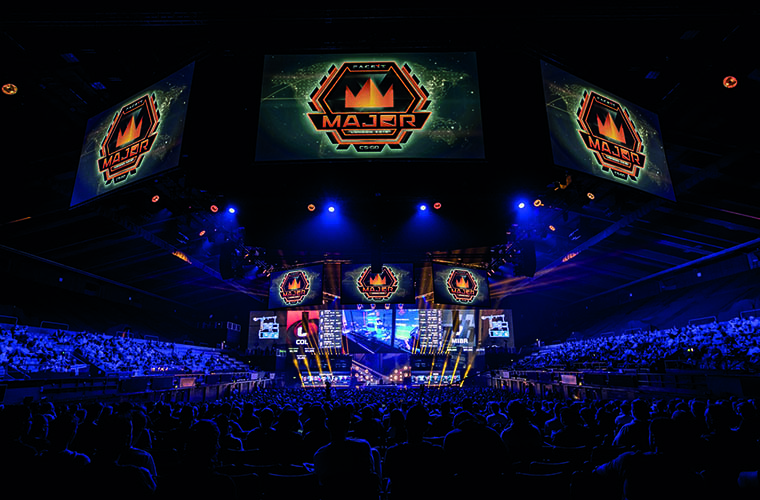Building an esports broadcast plan

Posted on Mar 20, 2020 by FEED Staff
Sponsored editorial
Putting together an esports broadcast requires some careful thinking, as well as knowing what you’re getting yourself into
Esports. It’s the same as regular sports except it’s all screens and mouses. Right? Well, yes and no. When a broadcaster approaches esports coverage, it needs to treat it like a ‘real’ sport, because it is one – and one that out-earns most other sports. But esports also needs its tailored approach. Just because you have thousands of hours of traditional sports coverage under your belt, don’t assume you can go into an esports broadcast without doing your homework.
The first thing to know is that not all esports matches are alike. There are several different varieties of esports games and each requires a different type of storytelling approach.
There are the first-person shooter (FPS) games, which have smaller teams, with the action usually in a one-on-one – or maybe two-on-two -scenario. Real-World analogues are team sports with clear goals like football or tennis. This model can apply to the multiplayer FPS games like Overwatch. Battle Royale games – like Fortnite – offer a similar first-person game view, but are an all-against-all Hunger Games-style affair. Individuals may create tactical alliances during the game, but ultimately there will only be one winner. Battle Royale games can have dozens of participants , which makes storytelling challenging, but opens up fascinating opportunities for parallel coverage of different player moments.
Then there are the multiplayer online battle arena (MOBA) games like League of Legends and Dota 2. These are very much built around teams against teams, and usually offer a bird’s-eye view of the entire game, rather than the first-person angles of the FPS games.
“How you tell the story for each of these games is an important part of planning the production and what you’re going to require for it,” explains Chris Merrill, director of product marketing at broadcast solutions provider, Grass Valley. “Like in traditional sports broadcasting, there are fixed camera positions, but then imagine that you could also have a large array of drone cameras on the field and that every player has a body cam. You’re exponentially growing the number of potential points of view that could be offered to the audience.”
Esports can also allow for points of view virtually impossible in traditional sports – observers standing in the middle of action. Virtual cameras can move anywhere in a a game scenario and can help turn a FPS esports event into something closer to cinematic entertainment.
Esports tournaments are also big events in their own right. There can be as much spectacle in the arena space as there is in the competition itself. Some tournaments have featured dramatic pyrotechnics, music performance and dramatic mixed-reality presentations. So esports coverage needs to be ready to present both the big game and the half-time show combined.

The elements that are woven to create an esports broadcast are, first, the game story, which is what generally appears on the screens in the arena itself. This shows the gameplay – often what the players are seeing, as well as points of view from virtual observer cameras.
Then there are other entertainment elements interspersed with the game story. These include arena performances, animations or real-world entertainment supporting the match.
Additionally there is the game commentary – known as ‘shout casting’ – which may not even take place at the venue. Game feeds can be sent to the remote location, where shoutcasting and graphics are added, before being sent to audiences internationally.
There are roughly free types of event set up for an esports game. There are the travelling in-arena events, set up and ticketed like a big concert at a local venue and built around a particular game or tournament. “These are produced very much like a rock concert,” says Grass Valley’s Merrill. “You need equipment that travels and is portable and can be set up easily repeatedly.”
Second, there are dedicated esports stadiums – like the MGM Grand HyperX Esports Arena in Las Vegas – that are built to be multipurpose. “Venues like these are dedicated to esports, but you can bring in lots of different types of games. They can be very flexible in the number of camera feeds they handle and their equipment can adapt to the different games played there,” explains Merrill.
Then there are facilities that are purpose-built for only one or two specific games. Burbank’s Blizzard Elite Arena is an example, and Riot Games has also made moves in this direction.
How you tell the story for each of these games is an important part of planning the production and what you’re going to require for it
“This is where you are getting into a different business model. These are often sponsored by rights holders for the games. And league team owners are starting to build these, too,” he adds.
Last year, Blizzard introduced the idea of ‘home’ and ‘away’ Overwatch games, with every team across the US having their own stadium. Every team hosts a minimum of two home matches throughout the season.
“Some people are still putting everything in a flypack and sending it off to the next event, which can make it hard to keep the product consistent. But many are standardising and – wherever possible – using some sort of remote production model,” says Merrill. “We have production gear in a lot of those stadiums. We’re trying to meet customer needs where they are, but we realise that this is an evolving industry.”
He concludes: “What they like about the fact that it’s broadcast gear is that you can always find a pool of freelancers familiar with it. They know it can handle the scale of the productions. When you’re talking about Fortnite and 100 cameras, it’s beyond what most people are capable of doing.”
This article first appeared in the March 2020 issue of FEED magazine.











